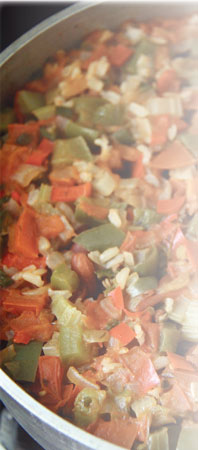By Julia Powers.

Anytime you sit down to eat with your loved ones, everyone around the table wins!
What does dinnertime look like at your house? Is it like a Norman Rockwell painting, with the family gathered around the table enjoying a nutritious, home-cooked meal and reconnecting after a busy day? These days…not likely! For many families, this type of dinner seems out of reach. Parents work long days only to come home and spend hours driving their kids to basketball practice, ballet, karate, or the activity du jour. Partners arrive home late from business trips. Young kids need baths, and teens, facing hours of homework, just want to sequester themselves in their rooms. Trying to get family members around the table at the same time seems like a daunting task, let alone finding time to actually cook the meal. Despite all these obstacles, sharing a family meal is one of the simplest, yet most impactful, ways to nourish your family on so many levels. Making family dinner a reality takes flexibility, commitment, and planning, but we have some tips, tricks, and tools that will have you calling “dinner’s ready” before you know it.
Most of us intuitively know that the advantages of a gathering at the end of the day to share a meal are many. Research bears out that these benefits are real and, indeed, so important that it is worth making a commitment to eating together at least a few times a week. Studies indicate that children whose families regularly eat together have a lower risk for depression, for developing eating disorders, and for obesity. In addition, researchers have found that consistent family mealtimes reduce the risk for both teen pregnancy and substance abuse. In families where mealtime is a priority, studies have also shown that it boosts children’s self-esteem, increases their resiliency, and leads to better academic performance. Are there a certain number of dinners that lead to these outcomes? Researchers have found that families who eat at least five meals together per week reap huge rewards, but there is no “magic number;” anytime you sit down to eat with your loved ones, everyone around the table wins.
Despite all the benefits, family dinners have become a casualty of our busy, overscheduled lives. But, you can take back dinnertime! We asked our readers to share some of their best tips, tricks, and recipes that help them make consistent family dinners a reality.
Making a List and Checking It Twice
It has been said that a goal without a plan is a wish. And, as many of our readers can attest, a few minutes spent planning the week’s menu is a key step in setting yourself up for dinnertime success. Reader Lisa Azizian advises, “Having a plan so you don’t have to think about it at the 11th hour is really critical.” When working on a weekly meal plan, it is helpful to consult the family calendar and take into account your afternoon and early evening commitments. If you know that your daughter has games on Wednesdays and you won’t pull into the driveway until 7:00 pm, then that would be a good night to plan a dinner prepared in the slow cooker. Not only will you be greeted with heavenly scents when you walk into the house; dinner will be on the table by 7:15 pm. Another reader, Sarah Murray of Heart Beets Farm, offers great advice to “Make a realistic meal plan for the week and stick to it. If you are a novice in the kitchen keep it simple with quick recipes and don’t overwhelm yourself with lots of extra steps and dishes.”
If the process of deciding on what meals to make seems daunting, try this simple trick: keep a list of your family’s favorite meals tacked to the inside of a cabinet door, segmented into categories such as chicken, vegetarian, beef, and pasta. When you sit down to make your shopping list, a quick scan will remind you of any meals you might have forgotten or ones that have been out of the rotation for a while. In terms of the grocery list itself, make your time at the farmers’ market or grocery store as productive as possible by grouping the items you need into sections such as produce, meat, deli, and dairy. This will help you navigate the market as efficiently as possible.
Adopt the Boy Scout Motto
Be prepared! When you arrive home from the market, follow reader Ashley Sorrondeguy’s guidance to “Wash and cut the vegetables. Making large batch chicken and beef stocks are great as well. We try to have some on hand in the freezer for quick soups or to add some flavor to dishes like stir-fries and rice.”
Another reader, Lindsay Kelliher, points out that “A well-stocked pantry and freezer makes last minute ‘thrown together meals’ a lot easier.” What constitutes a well-stocked pantry differs from household to household, based on their own style of eating, but can include oils, vinegars, spices, condiments such as soy sauce and sriracha, nut butters, dried grains, beans, legumes, pasta, onions, garlic, and sweet potatoes. Some helpful standbys to have in the refrigerator and freezer include eggs, butter, lemons, limes, broccoli, carrots, frozen chicken or beef stock, frozen wild-caught shrimp, frozen berries, and, for meat-eating families, a few favorite cuts of meat.
For anyone who has ever read a recipe, only to wilt with disappointment that it calls for marinating chicken for several hours before cooking, reader Felicia Pakalnis offers a great suggestion. She advises, “Make a marinade, take two or three chicken breasts and place in a Ziploc. Add the marinade. Make three or four bags. Freeze. When you need one for dinner, take out the Ziploc from the freezer, place in the fridge in the morning to defrost. By the time you come home from work, it should be thawed and ready for you to cook, already flavored.”
Batch Cooking to the Rescue
If you want to consistently get dinner on the table each week, meet your new best friend: batch cooking. Set aside a few hours each weekend to prep foods that can be used in meals throughout the week. These building blocks will help you get dinner on the table, no matter how hectic life gets. For example, on Sunday afternoon, roast two chickens; serve one for dinner and carve the other to use in chicken tacos the next day. Roast several sheet trays of veggies to be used in recipes throughout the week: sprinkle them into frittatas, tuck them into tacos, and incorporate them into grain bowls. Or follow reader Erin Carpenter’s lead an “Make soups and stews most weekends, pack in serving sizes and pop in the freezer.” Another approach is to double whatever you are cooking and freeze a batch for later. As reader Sarah Kulakovich notes, “Having a pre-cooked dish ready to warm is a treasure on a busy night.” Batch cooking can be an enjoyable process; play your favorite music or podcasts and include your kids. Not only is it a chance to spend time with one another, but by cooking together, you are teaching them a valuable skill that they will use daily in their adult lives.
Leftover Magic
While leftovers get a bad rap, they can be an important part of your weekly meal plan. But if you want to avoid a chorus of “not this again,” the key is to repurpose the leftovers into a different meal. Cube leftover pork tenderloin and incorporate it with leftover vegetables and rice, along with a few eggs, into pork fried rice. Or, combine leftover roasted butternut squash, canned black beans, an avocado, and some cilantro to make delicious vegetarian tacos. Get creative, and if you need some inspiration, Instagram and food blogs are great sources of ideas and recipes.
Kitchen Helpers
The slow cooker–and its fancier cousin, the Instant Pot–can be valuable allies on busy weeknights. Both appliances are ideal for cooking soups, stews, or braising tougher cuts of meat that benefit from long, slow cooking. In addition, the Instant Pot is a multi-tasking appliance that can act as a slow cooker, electric pressure cooker, rice cooker, steamer, yogurt maker, sauté/browning pan, and warming pot. Since the Instant Pot can cook foods up to 70% faster than conventional methods, it can be of great help when your goal is to get dinner on the table quickly. It is also ideal to use when batch-cooking rice and other grains to incorporate into your meals throughout the week.
Whichever appliance you choose to use, it can be helpful to prep the ingredients the night before and, in the morning, simply add everything to the crockpot and switch it on. When you walk in the door that evening–voila! Your one-pot meal is ready to be served.
To reap the benefits of the family dinner, here is a recipe worth sharing: combine five family members (adjust the amount accordingly), nourishing food, conversation, a dash of gratitude and a sprinkle of laughter. Repeat nightly.
Yield: a strong, connected family.
Julia Powers made family dinners a priority for over 20 years (although now an empty nester). Evening meals were a cornerstone of her family’s life together–a source of both physical and emotional nourishment. Her biggest key to success: meal planning, as well as kids who learned early on to do the dishes!
Slow Cooker Shredded Chicken

The rectangular dish was made by Jill Tortorella of Antioch Pottery, Antioch IL. Available at Local Pottery, Norwell MA
This recipe from Julia Powers couldn’t be easier! There are only two ingredients here, so she advises using both well-raised chicken and a good-quality salsa. If she can’t get locally made salsa at her farmers’ market she’ll reach for Green Mountain Gringo. Julia uses this easy fix as a filling for tacos, burritos, quesadillas, or even as a topping for salad. Just add your choice of accompaniments— like black beans, corn, shredded lettuce, sliced avocado, shredded cheese, pickled onion, roasted chiles, sliced radishes.
- 4 boneless, skinless chicken breasts or thighs
- 2 cups salsa
Place chicken in a slow cooker or crockpot and cover with salsa. Cook on high for 4 hours or low for 6-8 hours; chicken should shred easily. Stir well before serving.
Serves 4 – 8, depending on application.
-JP
Lousiana Beans and Rice

This formula is flavorfully vegetarian as is, but feel free to execute the initial frying with bacon drippings or chunks or ham or sausage if you like. Simmer it up with any sort of stock you have on hand, for a meatier version. Recipe submitted by eSS&SC reader Ashley Sorrondeguy.
- 2 tablespoons olive or canola oil
- 1 onion, diced
- 2 stalks of celery, chopped
- 4 cloves of garlic, minced
- 1 green pepper, diced
- 1 red pepper, diced
- 2 – 4 jalapeno or shishito peppers, chopped
- 4 large tomatoes, cut into chunks (frozen or canned in winter)
- 4 cups vegetable or other stock
- 1 teaspoon dried oregano
- ½ teaspoon dried thyme
- 1 tablespoon cayenne pepper
- 1 teaspoon paprika
- 2 bay leaves
- 2 tablespoons Tabasco sauce, or to taste
- sea salt and freshly ground black pepper, to taste
- 2 cups uncooked brown rice
- 3 cups cooked or canned kidney beans (or other favorite legume)
- ¼ cup chopped fresh chopped parsley or cilantro, optional
Heat oil or other fat in a Dutch oven or other large heavy-bottomed pan over medium-high heat. Add the onion and sauté until soft. Add the celery, garlic, and fresh peppers, and sauté until just beginning to soften. Add tomatoes, herbs and spices and cook a few minutes more, then stir in the stock, rice, and remaining seasonings. Bring to a simmer, taste for salt, and turn to low and cover.
Simmer until the rice is cooked and the liquid is absorbed, about 30 to 45 minutes. Remove bay leaves, and gently stir in beans. Allow to heat through, and then serve topped with optional garnishes and more hot sauce on the side.
Serves 8.






